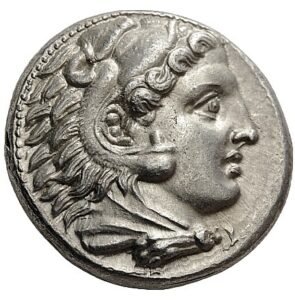
Coinage of Alexander the Great
The Coinage of Alexander the Great: Mints, Types, and Specifications
Alexander the Great’s coinage is among the most recognized and historically significant in the ancient world. Minted across his vast empire from 336–323 BCE, these coins unified economic systems, reinforced his image, and funded military campaigns. Below is a detailed list of the mints active during his reign, the types of coins they produced, their specifications, and descriptions.
Alexander the Great’s coinage is a testament to his unparalleled legacy as both a military leader and a unifier of cultures. His coins were more than just a medium of exchange; they were a political tool, a propaganda device, and a statement of his divine authority. Minted across his vast empire between 336 and 323 BCE, these coins helped establish economic stability, promote trade, and finance his conquests.
Iconography:
The coins often featured Heracles (Hercules) on the obverse, depicted wearing the Nemean Lion’s skin, symbolizing Alexander’s heroic lineage. The reverse typically displayed Zeus, seated on a throne, holding an eagle and a scepter, reinforcing Alexander’s divine right to rule. Gold staters sometimes bore images of Athena Nikephoros (Athena holding Nike, the goddess of victory), underscoring Alexander’s military successes.
Legends:
The coins were inscribed with the Greek legend ΑΛΕΞΑΝΔΡΟΥ (“Of Alexander”), signifying his authority and ensuring that his image endured even after his death. Some later issues included additional inscriptions or symbols to denote specific mints or local rulers acting in Alexander’s name.
Economic Purpose:
The gold, silver, and bronze coins served distinct purposes:
Gold Staters: High-value coins for international trade and paying soldiers.
Silver Tetradrachms and Drachms: Widely circulated coins for commerce and regional transactions.
Bronze Coins: Low-denomination coins for local use.
Minting Locations:
Alexander established or utilized mints in over 25 cities across his empire. These included key locations in Macedonia (Pella, Amphipolis), Asia Minor (Sardis, Ephesus), the Levant (Tyre, Sidon), Egypt (Memphis), and Persia (Babylon, Susa, and Persepolis). Each mint adapted the standardized design while occasionally adding local symbols or marks.
Significance:
The uniformity of Alexander’s coinage helped unify his diverse empire. These coins circulated far beyond his territories, influencing monetary systems in regions as distant as India and Central Asia. They also became a model for Hellenistic coinage, with successor states like the Seleucids and Ptolemies continuing the tradition.
Rarity and Collectibility:
Some coins, like those minted at Babylon or Aegae, are exceedingly rare today and highly prized by collectors. Unique symbols or control marks make certain issues particularly valuable.
Greek Mainland and Macedonia
1. Aegae (Vergina)
Type: Gold staters, silver tetradrachms, bronze coins
Weight & Diameter:
Gold staters: 8.6g, 18–19mm
Silver tetradrachms: 17.2g, 25–27mm
Bronze coins: 4–10g, 15–20mm
Legend: ΑΛΕΞΑΝΔΡΟΥ (Alexandrou)
Description: Located in Macedonia, Aegae was an early and significant mint, producing coins with Athena and Nike designs. It symbolized the power of the Macedonian royal dynasty.
Amphipolis
Type: Gold staters, silver tetradrachms, bronze coins
Weight & Diameter:
Gold staters: 8.6g, 18–19mm
Silver tetradrachms: 17.2g, 25–27mm
Bronze coins: 6–9g, 16–18mm
Legend: ΑΛΕΞΑΝΔΡΟΥ
Description: A prolific mint in eastern Macedonia, Amphipolis supported Alexander’s campaigns, producing coins with Heracles and Zeus imagery for trade and military use.
3. Pella
Type: Silver tetradrachms, bronze coins
Weight & Diameter:
Silver tetradrachms: 17.2g, 26mm
Bronze coins: 5–8g, 15–18mm
Legend: ΑΛΕΞΑΝΔΡΟΥ
Description: As the Macedonian capital, Pella’s coins were central to the regional economy and featured consistent, high-quality designs.
4. Eion
Type: Bronze coins
Weight & Diameter: 4–6g, 15–17mm
Legend: ΑΛΕΞΑΝΔΡΟΥ
Description: A smaller mint near Thrace, Eion’s coinage circulated locally, supporting regional trade.
—
Thrace and Northern Aegean
5. Maroneia
Type: Silver tetradrachms, bronze coins
Weight & Diameter:
Silver tetradrachms: 17.2g, 25–27mm
Bronze coins: 4–9g, 14–20mm
Legend: ΑΛΕΞΑΝΔΡΟΥ
Description: This Thracian mint produced coins that facilitated trade with neighboring regions.
6. Abdera
Type: Silver drachms, bronze coins
Weight & Diameter:
Silver drachms: 4.3g, 17–20mm
Bronze coins: 4–6g, 15–18mm
Legend: ΑΛΕΞΑΝΔΡΟΥ
Description: A coastal mint near Thrace, Abdera played a role in regional commerce, issuing smaller denominations for everyday transactions.
7. Sestos
Type: Silver drachms
Weight & Diameter: 4.3g, 18mm
Legend: ΑΛΕΞΑΝΔΡΟΥ
Description: Positioned near the Hellespont, Sestos controlled strategic trade routes between Europe and Asia.
—
Asia Minor
8. Sardis
Type: Gold staters, silver tetradrachms
Weight & Diameter:
Gold staters: 8.6g, 18–20mm
Silver tetradrachms: 17.2g, 25–27mm
Legend: ΑΛΕΞΑΝΔΡΟΥ
Description: A major mint in Lydia, Sardis was pivotal for minting coins that funded Alexander’s campaigns in Asia.
9. Ephesus
Type: Gold staters, silver drachms
Weight & Diameter:
Gold staters: 8.6g, 18–20mm
Silver drachms: 4.3g, 17–20mm
Legend: ΑΛΕΞΑΝΔΡΟΥ
Description: Renowned for its artistry, Ephesus struck coins that blended local and imperial designs.
10. Miletus
Type: Gold staters, silver drachms, bronze coins
Weight & Diameter:
Gold staters: 8.6g, 18–19mm
Silver drachms: 4.3g, 18mm
Bronze coins: 6–8g, 16–18mm
Legend: ΑΛΕΞΑΝΔΡΟΥ
Description: A major coastal mint that supported campaigns in western Asia Minor.
11. Halicarnassus
Type: Silver drachms, bronze coins
Weight & Diameter:
Silver drachms: 4.3g, 17–19mm
Bronze coins: 5–7g, 15–18mm
Legend: ΑΛΕΞΑΝΔΡΟΥ
Description: Located in Caria, Halicarnassus supported both local and military economies.
12. Colophon
Type: Silver tetradrachms, bronze coins
Weight & Diameter:
Silver tetradrachms: 17.2g, 25–27mm
Bronze coins: 6–9g, 16–18mm
Legend: ΑΛΕΞΑΝΔΡΟΥ
Description: This mint produced coins with high artistic value and wide circulation.
—
Eastern Mediterranean and Levant
13. Tarsus (Cilicia)
Type: Silver tetradrachms, bronze coins
Weight & Diameter:
Silver tetradrachms: 17.2g, 26mm
Bronze coins: 6–9g, 16–18mm
Legend: ΑΛΕΞΑΝΔΡΟΥ
Description: Supported Alexander’s eastern campaigns and trade in the Levant.
14. Tyre
Type: Silver tetradrachms
Weight & Diameter: 17.2g, 26mm
Legend: ΑΛΕΞΑΝΔΡΟΥ
Description: A key mint in Phoenicia, Tyre produced coins for regional trade and military use.
—
Significance of Coinage of Alexander the Great
Alexander’s coins, standardized across the empire, symbolized unity, economic strength, and his divine authority. Gold and silver coins primarily supported military campaigns and international trade, while bronze coins facilitated local transactions.


Leave a Reply